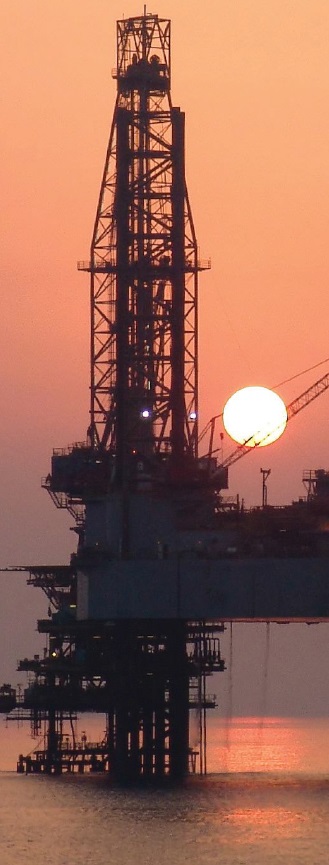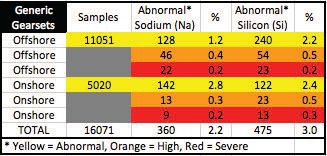Complexity in oil analysis: Part VII
Jack Poley | TLT On Condition Monitoring November 2012
Good maintenance practices can prevent lubricant contamination on offshore platform components.

www.canstockphoto.com
LET’S CONTINUE WITH HYDROCARBON DRILLING, as was discussed in the last column (September).
When I differentiate offshore from onshore drilling, sodium (Na) and silicon (Si) come to my mind, respectively. One would expect higher Na in saltwater operations and higher Si in land operations where abrasives are more likely to exist. I decided to look at some data in this regard, and this is what I found (
see Figure 1).
 Figure 1.
Figure 1.
I selected gears because they are generally the least protected (and respected) component types in most machinery groups. This probably stems from the fact that gears seem to be less affected than, say, hydraulics by contamination in terms of their ability to perform their function. I suppose, too, my thinking was also that if there were going to be incidents of Na and Si, gearsets would be most likely to manifest them.
A total of 16,071 drilling platform gearset samples were sorted. First, by offshore versus onshore, then as to number of samples with Abnormal* Na and Si. Abnormal signifies any values deemed Abnormal, High or Severe, all actionable data ratings.
The first point to note is that the number of incidents of either Na or Si is quite small or reasonable in the face of the sample total queried and in consideration of the relatively harsh environments these components encounter.
Second, there is virtually no difference between the ratio of incidents of either element, whether the operation is offshore or onshore. While individual samples might have shown very specific differences, the overall view is that offshore or onshore environments are well managed with respect to controlling Na and Si.
So much for Evaluation 101. One had best not make assumptions, e.g., that data must necessarily follow a logical path just because the odds would seem to favor such. As noted before, there is often more than one context from which to view data.
Based on these oil analysis data, the drilling industry, in general, is to be applauded with respect to maintenance practices aimed toward environmental ingress, particularly with respect to land-based operations as to Si control. Sufficient care is taken such that abrasives are very rare as an operating or environmental consequence, i.e., carelessness in handling and replenishing lubricants in components is rare and so is compromise of air cleaners and breathers.
Likewise we’ve rarely seen blatant saltwater contamination on offshore platform components. Again, there has to be a concerted effort to prevent seawater from entering lubricated sumps. Prevention like this is hardly accidental—evidence of good maintenance efforts.
One treacherous contaminant is drilling mud. For example, once it enters a sump, seals are compromised in mud pumps or top drives. But that is an event type usually not within a maintenance function’s purview to control or prevent. The best that can be done there is to: (1.) Check seals routinely for visual evidence of possible compromise and (2.) Be certain that one’s OA program is looking at various metals and combinations, thereof, to spot such a development at earliest stages.
Metals in this watch can include aluminium (Al), silicon (Si), sodium (Na), boron (B), potassium (K), phosphorus (P) and calcium (Ca). Accordingly it’s a good idea to occasionally have routinely used mud concoctions tested to see what metals flash, providing a pattern blueprint that can be monitored.
It goes without saying that having an intelligent agent monitor these patterns can be highly useful and much less prone to oversight when a complex pattern emerges.
 Jack Poley is managing partner of Condition Monitoring International (CMI), Miami, consultants in fluid analysis. You can reach him at jpoley@conditionmonitoringintl.com
Jack Poley is managing partner of Condition Monitoring International (CMI), Miami, consultants in fluid analysis. You can reach him at jpoley@conditionmonitoringintl.com.
For more information about CMI, visit www.conditionmonitoringintl.com.